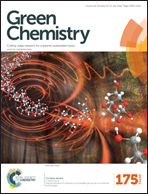A recycled foam coloring approach based on the reversible photo-isomerization of an azobenzene cationic surfactant†
Abstract
Development of a non-polluting process for cotton coloring is essential for the textile industry in view of ecological and economical reasons. In order to recycle the residual foam in the foam technique, a photo-responsive azobenzene cationic surfactant (4-butoxy-4′-(trimethylaminoethoxy)azobenzene, BTAEAzo) was synthesized for obtaining switchable foam based on its sensitive and reversible photo-isomerization capability. Trans → cis isomerization of BTAEAzo occurred only within 1 s UV light irradiation and cis → trans conversion could be achieved after 8 min visible light irradiation. Besides, BTAEAzo showed good thermal stability which was stable up to 225 °C. BTAEAzo was able to reversibly switch foam between the stable (t1/2 of 19.09 min) and unstable (t1/2 of 2.93 min) states by light stimulation. Furthermore, dye-bonded blocked waterborne polyurethane, a polymeric dye, was applied in the switchable system and showed no influence on the foam switching capability of BTAEAzo. The coated cotton presented superior color properties including the K/S value, color evenness and fastness with the switchable foam. Most importantly, the residual color foam can be re-used during the coating process with excellent color repeatability. These results demonstrated that the recycled foam coloring process containing only two types of chemicals is a rapid and nearly zero-pollution process, fostering a clean and green textile industry.


 Please wait while we load your content...
Please wait while we load your content...